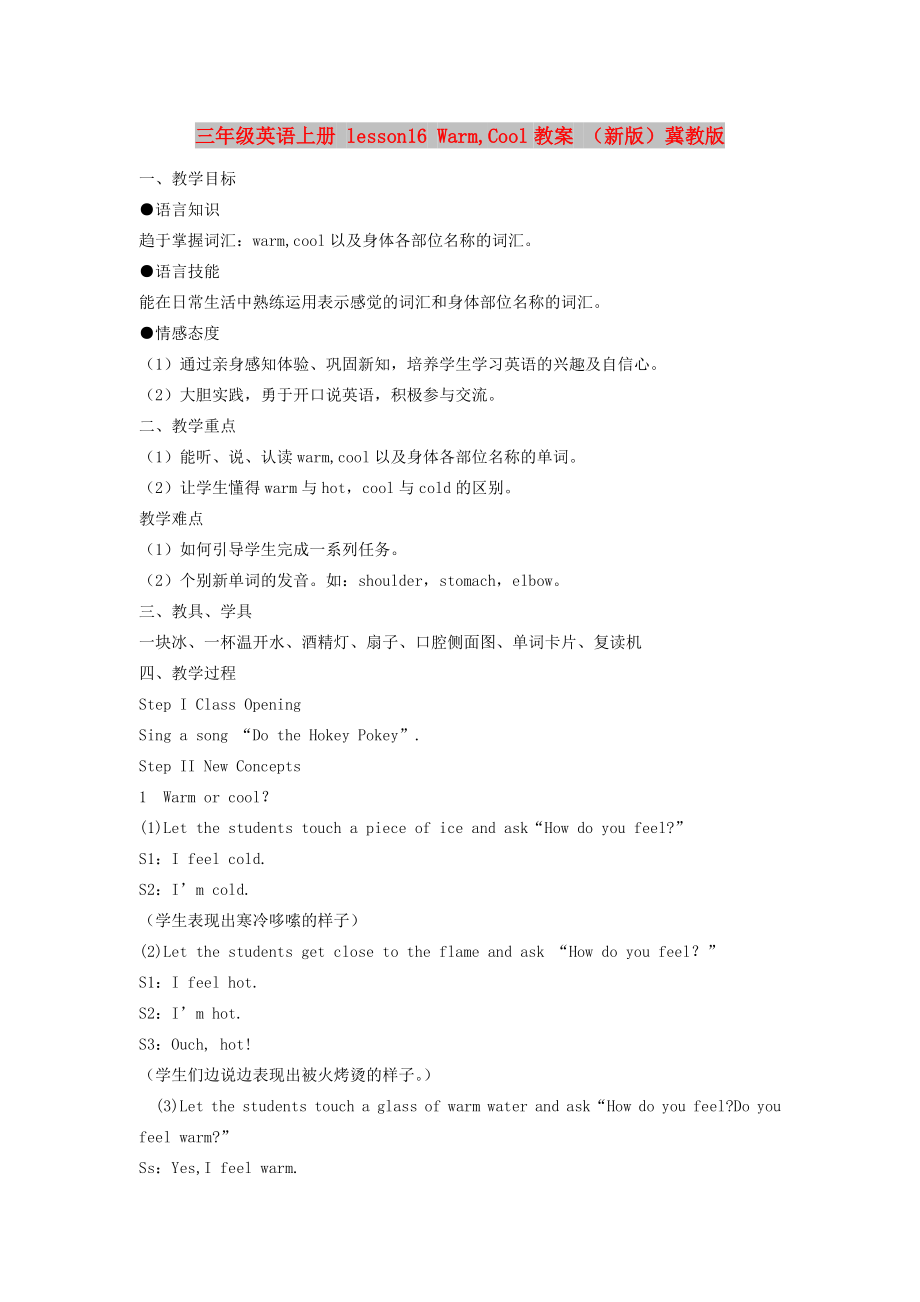《三年級(jí)英語(yǔ)上冊(cè) lesson16 Warm,Cool教案 (新版)冀教版》由會(huì)員分享��,可在線閱讀����,更多相關(guān)《三年級(jí)英語(yǔ)上冊(cè) lesson16 Warm,Cool教案 (新版)冀教版(5頁(yè)珍藏版)》請(qǐng)?jiān)谘b配圖網(wǎng)上搜索。
1����、三年級(jí)英語(yǔ)上冊(cè) lesson16 Warm,Cool教案 (新版)冀教版
一、教學(xué)目標(biāo)
●語(yǔ)言知識(shí)
趨于掌握詞匯:warm,cool以及身體各部位名稱的詞匯����。
●語(yǔ)言技能
能在日常生活中熟練運(yùn)用表示感覺(jué)的詞匯和身體部位名稱的詞匯。
●情感態(tài)度
(1)通過(guò)親身感知體驗(yàn)��、鞏固新知��,培養(yǎng)學(xué)生學(xué)習(xí)英語(yǔ)的興趣及自信心��。
(2)大膽實(shí)踐�����,勇于開(kāi)口說(shuō)英語(yǔ)����,積極參與交流。
二���、教學(xué)重點(diǎn)
(1)能聽(tīng)����、說(shuō)�、認(rèn)讀warm,cool以及身體各部位名稱的單詞��。
(2)讓學(xué)生懂得warm與hot��,cool與cold的區(qū)別����。
教學(xué)難點(diǎn)
(1)如何引導(dǎo)學(xué)生完成一系列任務(wù)����。
(2)個(gè)別新單詞的發(fā)音。
2�����、如:shoulder����,stomach,elbow��。
三���、教具�、學(xué)具
一塊冰�����、一杯溫開(kāi)水、酒精燈�、扇子��、口腔側(cè)面圖�、單詞卡片、復(fù)讀機(jī)
四�、教學(xué)過(guò)程
Step I Class Opening
Sing a song “Do the Hokey Pokey”.
Step II New Concepts
1Warm or cool?
(1)Let the students touch a piece of ice and ask“How do you feel?”
S1:I feel cold.
S2:I’m cold.
(學(xué)生表現(xiàn)出寒冷哆嗦的樣子)
(2)Let the s
3�����、tudents get close to the flame and ask “How do you feel���?”
S1:I feel hot.
S2:I’m hot.
S3:Ouch, hot!
(學(xué)生們邊說(shuō)邊表現(xiàn)出被火烤燙的樣子�����。)
?(3)Let the students touch a glass of warm water and ask“How do you feel?Do you feel warm?”
Ss:Yes,I feel warm.
(4)Let the students pass the glass of warm water.The one who g
4�、ets it should tell his/her feelings.
S1:I feel warm.
S2:I’m warm.
?(5)Fan the students and ask“How do you feel?Do you feel cool?”
S1:I feel cool.
S2:I’m cold.
(6)Let one student fan another one and ask “How do you feel?/Do you feel cool?/Are you cool?”引導(dǎo)前面的同學(xué)用扇子給后面的同學(xué)扇風(fēng)�。邊扇動(dòng)扇子邊問(wèn):
a:How do you
5、feel?
b:Do you feel cool?
c:Are you cool?
?(7)Write the new words on the blackboard and practice.
① read by themselves
② read in pairs
(找?guī)捉M同學(xué)到前面來(lái)演示���。一個(gè)說(shuō)單詞warm,一個(gè)表現(xiàn)出冬天穿上棉衣時(shí)溫暖的感覺(jué)���;一個(gè)說(shuō)單詞cool,一個(gè)表現(xiàn)出炎熱的夏季吃冰淇淋的樣子��。學(xué)生配合得很默契��。)
③ read one by one
④ read together
2What is it?
(1)Let the students touch m
6��、y hands and ask“How do you feel?”Then put up two hands and ask“What are they?”
Ss:I feel warm.
Ss:They are hands.
?(2)Point to the shoulder and ask“Whats this?”
(學(xué)生搖搖頭�,顯出疑問(wèn)的樣子�����。)
T:Its a shoulder.(手指一個(gè)肩膀)
Ss:Shoulder.(學(xué)生驚喜地瞪大了眼睛)
T:They are shoulders.(雙手指兩個(gè)肩膀)
Ss:Shoulders.
?(3)Put a pictu
7�����、re of body on the blackboard and teach the new word“shoulder”.
(齊讀�����,小組讀�����,個(gè)別讀,一條龍讀)
(4)Let the students look at the picture and study the other new words:stomach, elbow,knee,toe and finger.
(個(gè)別學(xué)生發(fā)音困難�。針對(duì)這一問(wèn)題,我用口腔側(cè)面圖來(lái)演示舌頭在口腔里的運(yùn)動(dòng)�,使學(xué)生準(zhǔn)確發(fā)音。)
shoulder(舌頭向上卷曲�����、口形棗圓狀)
elbow(舌頭平放�、口呈橢圓形)
(學(xué)生驚奇地瞪大了眼睛觀看口腔側(cè)面圖來(lái)
8��、糾正自己的發(fā)音��。)
[設(shè)計(jì)思路:學(xué)生對(duì)口腔側(cè)面圖很感興趣�,他們很快掌握了準(zhǔn)確的發(fā)音,使教學(xué)達(dá)到了事半功倍的效果�。]
(5)Put the cards on the picture of? body and practice.
① read one by one
② read by themselves
③ read in pairs
Step III Consoliation
1Play a game.
老師說(shuō)單詞,學(xué)生指向相應(yīng)的身體部位���;老師指身體部位���,學(xué)生說(shuō)出對(duì)應(yīng)的單詞??梢约由蟞ead,eye,ear,mouth,nose,left,right這些已經(jīng)學(xué)過(guò)的詞�。
2
9��、Sing a song.(邊唱邊指向身體的各個(gè)部位)
3引導(dǎo)學(xué)生換掉身體部位的詞語(yǔ)填上自己的歌詞���。(邊唱邊表現(xiàn)出相應(yīng)的表情)
Step IV? Class Closing
Let the studeats put the feeling words in their new song.Sing the song to their friends and their parents.
板書(shū)設(shè)計(jì)
Lesson 16:Warm,Cool
warm--------cool
shoulder? stomach? elbow
knee????? finger?? toe
課后反思:
10�、
附送:
2019-2020年三年級(jí)英語(yǔ)上冊(cè) lesson17 Are You Okay教案 (新版)冀教版
一��、教學(xué)目標(biāo):
1�����、知識(shí)與技能:
能理解并口頭應(yīng)答下列句子:
How are you? I feel sick. My ____hurts./ I have a ____ache.
Are you okay?Yes/No.
What’s the matter? I curt/hurt my ____.
2�����、情感與態(tài)度:
在學(xué)習(xí)中學(xué)會(huì)合作����,學(xué)會(huì)關(guān)心他人。
3�、過(guò)程與方法:
采用合作式的方法進(jìn)行學(xué)習(xí)。
二����、教學(xué)重點(diǎn):
能夠理解并口頭應(yīng)答下列句子:
How ar
11���、e you? I feel sick. My ____hurts./ I have a ____ache.
Are you okay?Yes/No.? What’s the matter? I curt/hurt my ____.
三、教學(xué)難點(diǎn):
能針對(duì)不同句式進(jìn)行準(zhǔn)確回答�����。
四�、教具:椅子、錄音機(jī)��、手偶�、醫(yī)用白大褂
教學(xué)過(guò)程:
一����、問(wèn)候:
Hello,boys and girls.
How are you?
How do you feel?
二、唱<>
達(dá)到既復(fù)習(xí)又活躍課堂氣氛的目的����。
三、游戲:
1����、SIMON
12、 SAYS
How are you? I feel sick. My ____hurts./ I have a ____ache.
Are you okay?Yes/No.
What’s the matter? I curt/hurt my ____.
可用Touch your ____.句式進(jìn)行此游戲���,以復(fù)習(xí)身體部位單詞�。
2、CHARADES
用此游戲復(fù)習(xí)sad,happy,tired,hot和cold等表示感覺(jué)的詞匯�����。
四��、教授How are you? I feel sick. My ____hurts./ I have a ____ache.
1���、示范
2�、利用一手偶
13����、與師完成下列對(duì)話:
手偶:How are you,today?
師:I feel sick.Sick.I am sick. Sick.(配合動(dòng)作和表情)
讓學(xué)生重復(fù)sick .
用自己的身體部位演示:My ____hurts./ I have a ____ache (ear, head ,stomach) 如可捧著頭說(shuō):My head hurts./I have a headache.出示句子及單詞讓學(xué)生重復(fù)說(shuō)�����。?
解釋ache通常表示陣痛��,尤其指耳朵��、頭和肚子的疼痛。還可以用hurts表示任何疼痛���。
五��、教授
Are you okay?Do you feel sick?
Wh
14�����、at’s the matter? I curt/hurt my ____.
1��、示范
利用手偶與師進(jìn)行對(duì)話
師:How do you feel? Do you feel sick?
手偶:My ____hurts./ I have a ____ache./I cut my ____.
2���、教給學(xué)生用How do you feel?或Are you okay?作為一般問(wèn)候語(yǔ)來(lái)詢問(wèn)別人的健康狀況,以示關(guān)心�。關(guān)心他人是我們應(yīng)具有的一種美德。
向?qū)W生說(shuō)明cut 用來(lái)描述任何如小刀之類鋒利東西的動(dòng)作����。What’s the matter?一般是護(hù)士或醫(yī)生詢問(wèn)病情時(shí)的句子�。出示nurse,認(rèn)讀�����。
3、學(xué)說(shuō)句子與師進(jìn)行對(duì)話�。
4、看書(shū)聽(tīng)錄音跟讀
5�����、分組編對(duì)話
設(shè)計(jì)背景和情況�����,編一個(gè)關(guān)于受傷或生病的對(duì)話
6���、小組展示對(duì)話
板書(shū)設(shè)計(jì):??????????
Lesson17: Are You Okay?
I feel sick.My _____hurts.
How are you?
I feel sick. I have a ____ache.
Are you okay?Yes/No.
What’s the matter?
 三年級(jí)英語(yǔ)上冊(cè) lesson16 Warm,Cool教案 (新版)冀教版
三年級(jí)英語(yǔ)上冊(cè) lesson16 Warm,Cool教案 (新版)冀教版

